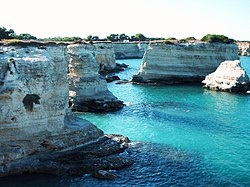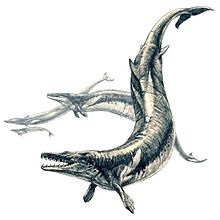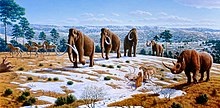|
|
| |
|
|
| |
|
|
|
|
| |
 |
| Rock deposits from
the Cenozoic Era (Torre Sant'Andrea, Salento,
Italy). |
Cenozoic
The Cenozoic Era (/ˌsiː.nəˈzoʊ.ɪk, -noʊ-, ˌsɛn.ə-, ˌsɛn.oʊ-/
see-nə-ZOH-ik, -noh-, SEN-ə-, SEN-oh-) meaning "new
life" is the current and most recent of the three
geological eras of the Phanerozoic Eon. The Cretaceous–Paleogene
extinction event (also referred to as the K-Pg, or K-T,
extinction event) is the boundary between preceding
Mesozoic era and the Cenozoic, which extends from 66
million years ago to the present day. Many species,
including all non-avian dinosaurs, became extinct, in an
event attributed by most experts to the impact of a
large asteroid or other celestial body, the Chicxulub
impactor.
The Cenozoic is also known as the Age of Mammals because
the terrestrial animals that dominated both hemispheres
were mammals – the Eutherians (placentals) in the
northern hemisphere and the Metatherians (marsupials,
now mainly restricted to Australia) in the southern
hemisphere. The extinction of many groups allowed
mammals and birds to greatly diversify so that large
mammals and birds dominated the Earth. The continents
also moved into their current positions during this era.
The Earth's climate had begun a drying and cooling
trend, culminating in the glaciations of the Pleistocene
Epoch, and partially offset by the Paleocene-Eocene
Thermal Maximum.
Nomenclature
Cenozoic, meaning "new life," is derived from Greek
καινός kainós "new," and ζωή zōḗ "life." The era is also
known as the Cænozoic, Caenozoic, or Cainozoic (/ˌkaɪnəˈzoʊɪk,
ˌkeɪ-/). The name "Cenozoic" (originally: "Kainozoic")
was proposed in 1840 by the British geologist John
Phillips (1800–1874). |
|
 |
| Basilosaurus. |
Divisions
The Cenozoic is divided into three periods: the
Paleogene, Neogene, and Quaternary; and seven epochs:
the Paleocene, Eocene, Oligocene, Miocene, Pliocene,
Pleistocene, and Holocene. The Quaternary Period was
officially recognized by the International Commission on
Stratigraphy in June 2009, and the former term, Tertiary
Period, became officially disused in 2004 due to the
need to divide the Cenozoic into periods more like those
of the earlier Paleozoic and Mesozoic eras. The common
use of epochs during the Cenozoic helps paleontologists
better organize and group the many significant events
that occurred during this comparatively short interval
of time. Knowledge of this era is more detailed than any
other era because of the relatively young,
well-preserved rocks associated with it.
Paleogene
The Paleogene spans from the extinction of non-avian
dinosaurs, 66 million years ago, to the dawn of the
Neogene, 23.03 million years ago. It features three
epochs: the Paleocene, Eocene and Oligocene.
The Paleocene epoch lasted from 66 million to 56 million
years ago. Modern placental mammals originated during
this time. The Paleocene is a transitional point between
the devastation that is the K-T extinction, and the rich
jungle environment that is the Early Eocene. The Early
Paleocene saw the recovery of the earth. The continents
began to take their modern shape, but all the continents
and the subcontinent of India were separated from each
other. Afro-Eurasia was separated by the Tethys Sea, and
the Americas were separated by the strait of Panama, as
the isthmus had not yet formed. This epoch featured a
general warming trend, with jungles eventually reaching
the poles. The oceans were dominated by sharks as the
large reptiles that had once predominated were extinct.
Archaic mammals filled the world such as creodonts
(extinct carnivores, unrelated to existing Carnivora).
The Eocene Epoch ranged from 56 million years to 33.9
million years ago. In the Early-Eocene, species living
in dense forest were unable to evolve into larger forms,
as in the Paleocene. All known mammals were under 10
kilograms. Among them were early primates, whales and
horses along with many other early forms of mammals. At
the top of the food chains were huge birds, such as
Paracrax. The temperature was 30 degrees Celsius with
little temperature gradient from pole to pole. In the
Mid-Eocene, the Circumpolar-Antarctic current between
Australia and Antarctica formed. This disrupted ocean
currents worldwide and as a result caused a global
cooling effect, shrinking the jungles. This allowed
mammals to grow to mammoth proportions, such as whales
which, by that time, had become almost fully aquatic.
Mammals like Andrewsarchus were at the top of the
food-chain. The Late Eocene saw the rebirth of seasons,
which caused the expansion of savanna-like areas, along
with the evolution of grass. The end of the Eocene was
marked by the Eocene-Oligocene extinction event, the
European face of which is known as the Grande Coupure.
The Oligocene Epoch spans from 33.9 million to 23.03
million years ago. The Oligocene featured the expansion
of grass which had led to many new species to evolve,
including the first elephants, cats, dogs, marsupials
and many other species still prevalent today. Many other
species of plants evolved in this period too. A cooling
period featuring seasonal rains was still in effect.
Mammals still continued to grow larger and larger.
Neogene
The Neogene spans from 23.03 million to 2.58 million
years ago. It features 2 epochs: the Miocene, and the
Pliocene.
The Miocene epoch spans from 23.03 to 5.333 million
years ago and is a period in which grass spread further,
dominating a large portion of the world, at the expense
of forests. Kelp forests evolved, encouraging the
evolution of new species, such as sea otters. During
this time, perissodactyla thrived, and evolved into many
different varieties. Apes evolved into 30 species. The
Tethys Sea finally closed with the creation of the
Arabian Peninsula, leaving only remnants as the Black,
Red, Mediterranean and Caspian Seas. This increased
aridity. Many new plants evolved: 95% of modern seed
plants evolved in the mid-Miocene.
The Pliocene epoch lasted from 5.333 to 2.58 million
years ago. The Pliocene featured dramatic climactic
changes, which ultimately led to modern species of flora
and fauna. The Mediterranean Sea dried up for several
million years (because the ice ages reduced sea levels,
disconnecting the Atlantic from the Mediterranean, and
evaporation rates exceeded inflow from rivers).
Australopithecus evolved in Africa, beginning the human
branch. The isthmus of Panama formed, and animals
migrated between North and South America during the
great American interchange, wreaking havoc on local
ecologies. Climatic changes brought: savannas that are
still continuing to spread across the world; Indian
monsoons; deserts in central Asia; and the beginnings of
the Sahara desert. The world map has not changed much
since, save for changes brought about by the glaciations
of the Quaternary, such as the Great Lakes, Hudson Bay,
and the Baltic sea. |
 |
| Megafauna of
Pleistocene Europe (mammoths, cave lions, woolly
rhino, reindeer, horses). |
Quaternary
The Pleistocene lasted from 2.58 million to 11,700 years
ago. This epoch was marked by ice ages as a result of
the cooling trend that started in the Mid-Eocene. There
were at least four separate glaciation periods marked by
the advance of ice caps as far south as 40° N in
mountainous areas. Meanwhile, Africa experienced a trend
of desiccation which resulted in the creation of the
Sahara, Namib, and Kalahari deserts. Many animals
evolved including mammoths, giant ground sloths, dire
wolves, saber-toothed cats, and most famously Homo
sapiens. 100,000 years ago marked the end of one of the
worst droughts in Africa, and led to the expansion of
primitive humans. As the Pleistocene drew to a close, a
major extinction wiped out much of the world's megafauna,
including some of the hominid species, such as
Neanderthals. All the continents were affected, but
Africa to a lesser extent. It still retains many large
animals, such as hippos.
The Holocene began 11,700 years ago and lasts to the
present day. All recorded history and "the Human
history" lies within the boundaries of the Holocene
epoch. Human activity is blamed for a mass extinction
that began roughly 10,000 years ago, though the species
becoming extinct have only been recorded since the
Industrial Revolution. This is sometimes referred to as
the "Sixth Extinction". It is often cited that over 322
recorded species have become extinct due to human
activity since the Industrial Revolution, but the rate
may be as high as 500 veterbrate species alone, the
majority of which have occurred after 1900. |
|
Animal life
Early in the Cenozoic, following the K-Pg event, the
planet was dominated by relatively small fauna,
including small mammals, birds, reptiles, and
amphibians. From a geological perspective, it did not
take long for mammals and birds to greatly diversify in
the absence of the dinosaurs that had dominated during
the Mesozoic. Some flightless birds grew larger than
humans. These species are sometimes referred to as
"terror birds," and were formidable predators. Mammals
came to occupy almost every available niche (both marine
and terrestrial), and some also grew very large,
attaining sizes not seen in most of today's terrestrial
mammals.
Early animals were the Entelodon, Paraceratherium (a
hornless rhinoceros relative) and Basilosaurus (an early
whale). The extinction of many large diapsid groups,
such as flightless dinosaurs, Plesiosauria and
Pterosauria allowed mammals and birds to greatly
diversify and become the world's predominant fauna.
Tectonics
Geologically, the Cenozoic is the era when the
continents moved into their current positions.
Australia-New Guinea, having split from Pangea during
the early Cretaceous, drifted north and, eventually,
collided with South-east Asia; Antarctica moved into its
current position over the South Pole; the Atlantic Ocean
widened and, later in the era (2.8 million years ago),
South America became attached to North America with the
isthmus of Panama.
India collided with Asia 55 to 45 million years ago
creating the Himalayas; Arabia collided with Eurasia,
closing the Tethys Ocean and creating the Zagros
Mountains, around 35 million years ago.
The break-up of Gondwana in Late Cretaceous and Cenozoic
times led to a shift in the river courses of various
large African rivers including the Congo, Niger, Nile,
Orange, Limpopo and Zambezi.
Climate
In the Cretaceous, the climate was hot and humid with
lush forests at the poles, there was no permanent ice
and sea levels were around 300 metres higher than today.
This continued for the first 10 million years of the
Paleocene, culminating in the Paleocene–Eocene Thermal
Maximum about 55.5 million years ago. Around 50 million
years ago the earth entered a period of long term
cooling. This was mainly due to the collision of India
with Eurasia, which caused the rise of the Himalayas:
the upraised rocks eroded and reacted with CO2 in the
air, causing a long-term reduction in the proportion of
this greenhouse gas in the atmosphere. Around 35 million
years ago permanent ice began to build up on Antarctica.
The cooling trend continued in the Miocene, with
relatively short warmer periods. When South America
became attached to North America creating the Isthmus of
Panama around 2.8 million years ago, the Arctic region
cooled due to the strengthening of the Humboldt and Gulf
Stream currents, eventually leading to the glaciations
of the Quaternary ice age, the current interglacial of
which is the Holocene Epoch. Recent analysis of the
geomagnetic reversal frequency, oxygen isotope record,
and tectonic plate subduction rate, which are indicators
of the changes in the heat flux at the core mantle
boundary, climate and plate tectonic activity, shows
that all these changes indicate similar rhythms on
million years' timescale in the Cenozoic Era occurring
with the common fundamental periodicity of ∼13 Myr
during most of the time. |
|
Life
During the Cenozoic, mammals proliferated from a few
small, simple, generalized forms into a diverse
collection of terrestrial, marine, and flying animals,
giving this period its other name, the Age of Mammals.
The Cenozoic is just as much the age of savannas, the
age of co-dependent flowering plants and insects, and
the age of birds. Grass also played a very important
role in this era, shaping the evolution of the birds and
mammals that fed on it. One group that diversified
significantly in the Cenozoic as well were the snakes.
Evolving in the Cenozoic, the variety of snakes
increased tremendously, resulting in many colubrids,
following the evolution of their current primary prey
source, the rodents.
In the earlier part of the Cenozoic, the world was
dominated by the gastornithid birds, terrestrial
crocodiles like Pristichampsus, and a handful of
primitive large mammal groups like uintatheres,
mesonychids, and pantodonts. But as the forests began to
recede and the climate began to cool, other mammals took
over.
The Cenozoic is full of mammals both strange and
familiar, including chalicotheres, creodonts, whales,
primates, entelodonts, saber-toothed cats, mastodons and
mammoths, three-toed horses, giant rhinoceros like
Indricotherium, the rhinoceros-like brontotheres,
various bizarre groups of mammals from South America,
such as the vaguely elephant-like pyrotheres and the
dog-like marsupial relatives called borhyaenids and the
monotremes and marsupials of Australia. |
|
|
|
|
|
|
|
|
|
|
|
|
|
|
|
|
|
|
Search Fun Easy English |
|
|
|
|
|
|
|
|
|
|
|
|
|
|
|
About
Contact
Copyright
Resources
Site Map |